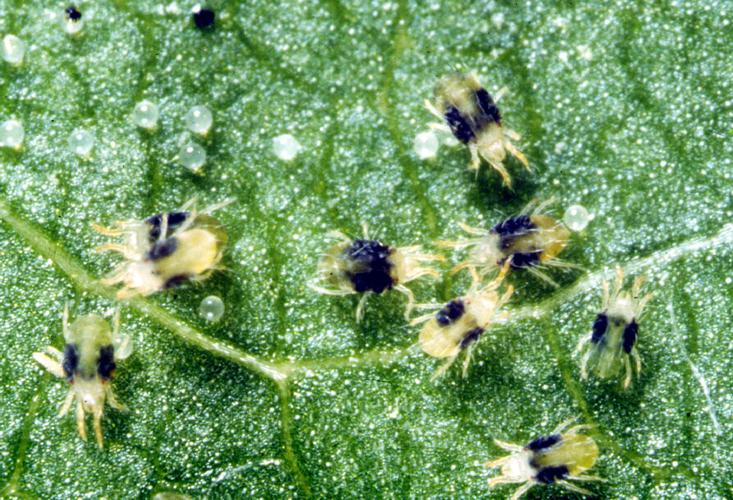Q: What do mites look like?
Answer: There are different kinds of mites. They are all related to spiders, ticks, and scorpions and they are members of the Arachnid class of Arthropods. The most common ones we see on plants are spider mites and resemble tiny spiders under magnification. Another type of mite that may be found on plants is called the eriophyid mite. These look more like maggots and are generally much smaller so you would probably need a microscope to see them. They sometimes cause plant galls to form where they feed. While some mites are plant feeders, some feed on mold, and dust mites feed on dead skin. Other mites are predators and parasites that feed on insects such as honey bees, animals such as birds and bats, or in the case of chiggers, animals like us. As the song goes, “Well little bugs have littler bugs upon their backs to bite ’em. And the littler bugs have still littler bugs and so ad infinitum.”
Q: I am finding strange growths on my oleander. What is causing this and what can I do about it?
A: Your oleander sample is showing symptoms of a witch’s broom (just in time for Halloween), caused by a fungus called Sphaeropsis tumefaciens that is commonly seen on oleander and other landscape plants. To manage this situation, prune branches at least 6 inches below where symptoms are seen. Look at the cut end of the stem to see if there’s any discoloration from the fungal growth in the wood. Prune that branch back further, if so. Make sure to prune during dry times, avoiding periods when rainfall is expected 24 hours before or after pruning. To prevent infection of unaffected plant parts, dip pruning tools in a disinfectant such as 10 percent Clorox or rubbing alcohol before using them on another branch or plant. If you have a bucket of bleach handy, with several pairs or pruners on hand, make one cut, then place the pruner in the bucket, and retrieve another one from the sanitizing solution. Bleach needs a good 30 seconds to sanitize the pruner surface if this disease is to be killed. Severely infected plants should be removed and destroyed. No chemical fungicides are available to control this disease. We don’t know of any Oleander cultivars that have resistance to this disease.
Q: I have lived in this house since it was built in 1978 and had never seen a scorpion. About three years ago, there was a major road construction project a half mile away and that’s when the scorpions started. They began showing up about once every two to three weeks. My regular exterminator comes in March, June and September and in addition to spraying inside and out, he began laying down scorpion granules at every visit. The scorpion visits became farther apart but have continued. I was just beginning to think they had finally disappeared until this last week when I saw one crawling around my desk where I work all day, every day. He missed my wrath that day but I saw him the next day in the bathroom (I’m fairly certain it was the same one). I dispatched him immediately. Why do these nasty critters keep showing up and how can I get rid of them once and for all? My house is clear of clutter inside and out and the weeds are kept at bay.
A: You may have answered your first question already. It could be that habitat destruction from the nearby road project may have played a role in diverting the scorpion population in your general direction. How you get rid of them requires an integrated pest management approach. Pest-proofing your home is an essential first step. You’re already on the right track by keeping the area surrounding your house free of weeds. Other things that allow them refuge are stacks of anything including woodpiles, stones, bricks, etc. Install weather-stripping around loose fitting doors and windows and ensure door sweeps are tight fitting. Store garbage containers in a frame that allows them to rest above ground level. Plug holes in brick veneer with steel wool, pieces of nylon scouring pad or small squares of screen wire. Caulk around roof eaves, pipes and any other cracks into the building. Keep window screens in good repair. Make sure they fit tightly in the window frame.
Scorpions are almost impossible to manage with insecticides alone. Because they are nocturnal, spraying in the daytime is ineffective. A proactive approach is to find them before they enter your house. Scorpions fluoresce or glow under ultraviolet light so they are easy to find with the aid of a black-light during the night. Nighttime scorpion hunting is a lot of fun but make sure that you wear boots and have long tongs if you want to capture the scorpions to move them. Black-lights can be ordered from the internet or obtained from pet stores and electronic retailers. Once located, collect the scorpions using long forceps and keep them in a sealable, sturdy container. As these wonderful creatures are such a benefit to our environment please consider collecting and releasing the scorpions into the natural desert rather than killing them.





